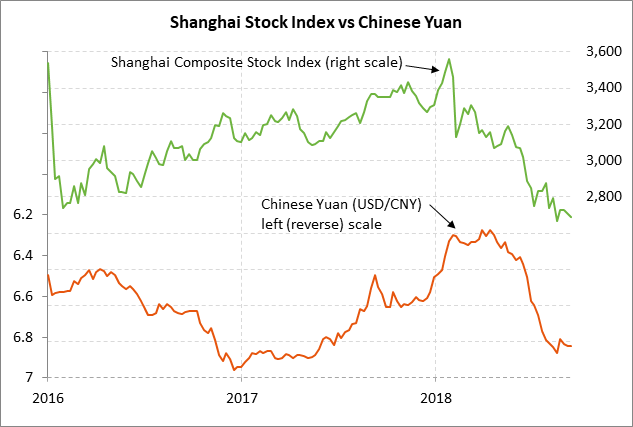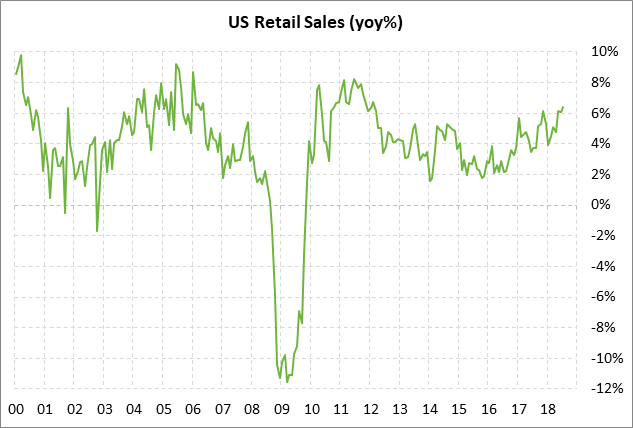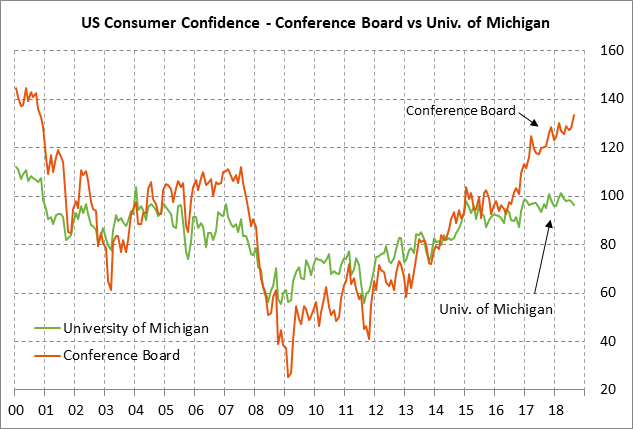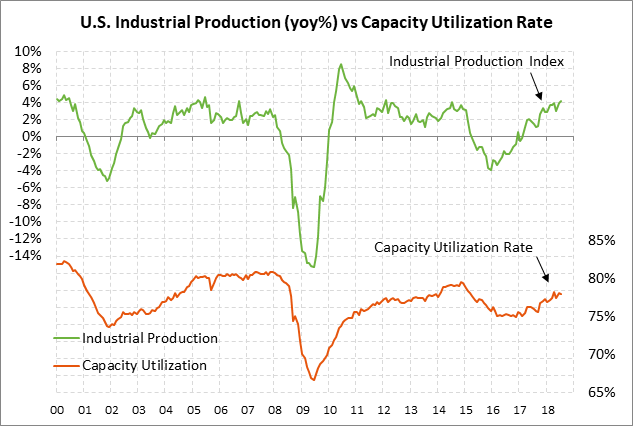- Odds further diminish for Oct 1 government shutdown
- Markets wait to see if there will be new US/Chinese trade talks
- U.S. retail sales expected to remain strong
- U.S. consumer sentiment expected to recover a bit
- U.S. manufacturing production growth expected to remain near 6-year high
- U.S. import prices expected to show monthly decline but remain generally strong
Odds further diminish for Oct 1 government shutdown — The odds have fallen farther for a U.S. government shutdown at the beginning of the new fiscal year in two weeks on Oct 1. There is now a bipartisan agreement for Congress in the next two weeks to pass regular spending bills for 90% of the government and to roll the rest of the spending over until December 7 with a continuing resolution (CR). The parts of the government covered by the CR will be for the departments of Homeland Security, State, Commerce, and Justice, and the science agencies.
President Trump seems to be on board with that plan but could nevertheless decide at the last minute to veto the spending bills and CR and in fact cause a broad government shutdown on Oct 1.
While the odds are low for an Oct 1 government shutdown, the odds are perhaps as high as 50-50 for a government shutdown after Dec 7 when the CR expires. Since he took office, President Trump has been trying to use a “good government shutdown” to get his border wall funding. He may finally get his opportunity for a showdown on Dec 7, i.e., after the November 6 mid-term elections. However, the impact of the shutdown would be reduced by the fact that the shutdown would involve only the 10% of the government funded by the CR since the rest of the government would already be funded through Sep 30, 2019.
Markets wait to see if there will be new US/Chinese trade talks — The markets are waiting to see if there will be new high-level US/Chinese trade talks after Treasury Secretary Mnuchin’s recent invitation to Chinese officials. There is no indication that China would bring any more concessions to the table than they did in the failed mid-level talks in late August. Nevertheless, the mere scheduling of talks could at least delay the Trump administration’s announcement of tariffs on another $200 billion of Chinese goods, which could occur at any time since the procedural prerequisites have been met.
President Trump in tweets on Thursday took umbrage at a WSJ story saying that the administration was offering trade talks with China to reduce the tariff-induced political damage ahead of the Nov 6 mid-term elections. Mr. Trump tweeted in part, “We are under no pressure to make a deal with China. They are under pressure to make a deal with us. Our markets are surging, theirs are collapsing.” The S&P 500 index this week in fact hit a record high while the Shanghai Composite fell to a 2-1/2 year low.
U.S. retail sales expected to remain strong — The market consensus is for today’s Aug retail sales report to show another strong increase of +0.4% and +0.5% ex-autos, adding to July’s report of +0.5% and +0.6% ex-autos. Retail sales have been very strong since March and showed year-on-year growth of +6.4% y/y in July, the strongest growth rate in 6-1/2 years.
Personal spending contributed a hefty 2.55 percentage points of growth to the Q2 GDP report of +4.2%. Looking ahead, the Atlanta Fed’s GDPNow is forecasting that personal spending will remain strong and contribute 2.08 points to growth in Q3, leading to their strong Q3 GDP forecast of +3.8%. The market consensus is for slower Q3 GDP growth of +2.8%.
U.S. consumer sentiment expected to recover a bit — The consensus is for today’s preliminary-Sep University of Michigan U.S. consumer sentiment index to show a modest increase of +0.4 points at 96.6, recovering part of August’s -1.5 decline to 96.2. The index showed back-to-back declines in July-Aug and fell to a 7-month low in August where it was down by 5.2 points from March’s 14-1/2 year high of 101.4.
However, the weakness in the University of Michigan’s consumer sentiment index needs to be taken with a grain of salt because the Conference Board’s U.S. consumer confidence index, by contrast, has shown surprising strength in recent months. In fact, the Conference Board’s index in August rose sharply by +5.5 points to a new 17-3/4 year high of 133.4.
U.S. consumer sentiment is seeing support from (1) the strong economy and labor market, (2) rising income and wages, and (3) rising household wealth with the steady rise in home prices and recent record highs in the stock market. Negative factors for consumer sentiment include (1) Washington political uncertainty, and (2) negative tariff impacts on domestic businesses and consumer prices.
U.S. manufacturing production growth expected to remain near 6-year high — The market consensus is for today’s Aug industrial production to show an increase of +0.3%, improving from July’s small +0.1% increase. Today’s Aug manufacturing production index is also expected to show an increase of +0.3%, matching July’s +0.3% increase.
The U.S. manufacturing sector is in good shape with year-on-year growth of +2.4% in July, which was a 6-year high. Confidence is also in good shape with the ISM manufacturing index in August unexpectedly rising by +3.2 points to a 14-year high of 61.3. The U.S. manufacturing sector is seeing support from the very strong U.S. GDP growth rate and increased business investment in the wake of the Jan 1 tax cuts.
U.S. import prices expected to show monthly decline but remain generally strong — The market consensus is for today’s Aug import price index to weaken to -0.2% m/m and +4.1% y/y from July’s report of unchanged m/m and +4.8% y/y. U.S. import prices are seeing some upward pressure from tariffs and the strong U.S. economy. However, the strong dollar is putting some downward pressure on import prices.




